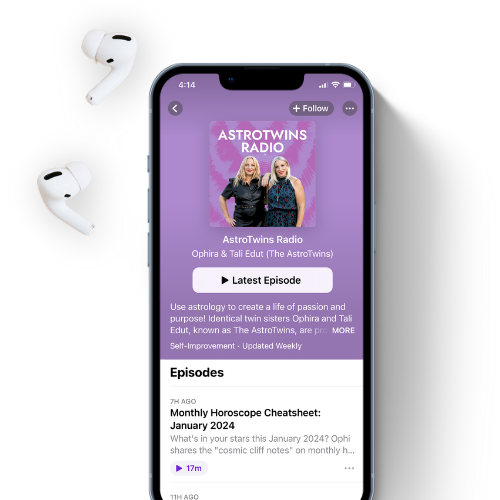The progressed chart in astrology shows where are you on your soul’s journey. It answers: how are you transforming with each year? Secondary progressions—also called a progressed chart—map your personal evolution over time.
Life is a journey and astrology operates the same way. Though each of us is born with planets in a fixed birth chart, we are shaped by outside influences like our environments, family structures, experiences and so on. The progressed chart is one way of tracking your cosmic evolution over time.
What’s the difference between my birth chart and my progressed chart in astrology?
Think of the birth (natal) chart as your factory settings. This is the “fresh out of the box” model of you, and reveals your fundamental nature. The progressed chart maps your system upgrades. You wouldn’t run an old Windows or IOS when a far more advanced software was available, right? The progressed chart keeps you updated over time.
Our new podcast is here!
AstroTwins Radio
Subscribe and join us every week wherever you get your podcasts!
Listen here
How do I calculate my progressed chart?
A progressed chart in astrology is calculated according to the “day per year” system. In other words, one year of life translates into one day on the ephemeris. You can run a progressed chart using this calculator below, but we will explain how it works using an “old school” ephemeris—the essential map for every astrogeek!
Show me this ephemeris thing…
Like we said, in a progressed chart in astrology, each day counts for a year of your life. Said another way, where the planets were on your first day of life is where they are in year one of your progressed chart. Stay with us here…
Let’s use our birthday of December 2, 1972 as an example. If we wanted to see our secondary progressions at age 3, we’d pull up a 1972 ephemeris and count three days from our birthday to December 5, 1972. We love the Swiss ephemeris that’s available for free at astro.com. Have your pick of 9000 years of them right here!
The only change here? On December 2, our birthday, the moon was in Scorpio. On December 5, the moon has moved into Sagittarius. Thus, at age 3, we had a change to our progressed moon. Sounds minor, but it’s not! The progressed moon is incredibly fundamental to casting these types of charts…more on that shortly.
Reading into the progressed chart in astrology
Interestingly enough, it was at age 3 that our parents left the comfort of our grandparents’ home and moved the family into a house of our own. This felt like an abrupt and unsettling change—and was particularly stressful for our Sagittarius father. The Scorpionic security was replaced with a new sense of Sagittarian independence. We also began reading that year, which is in alignment with the bookish way of Sagittarius.
At age 5 (December 7, 1972) our progressed moon was still in Sagittarius. That year, our obsession was memorizing state capitols and countries across the world — instead of puppy and kitten posters, we had a giant map hanging on our bedroom wall! Hello, globetrotting Sag progressed moon.
And then what do you do with a progressed chart?
Now, let’s jump ahead a few decades. In 2014, we turned 42. To find our current progressed chart we count 42 days from our birthday which takes us all the way to January 14, 1973.
All of the inner planets (the planets before Jupiter) have progressed to new signs:
- Our natal moon has progressed from Scorpio to Taurus
- Our natal Mercury has progressed from Scorpio to Capricorn
- Our natal Venus has progressed from Scorpio to Capricorn
- Our natal Mars has progressed from Scorpio to Sagittarius
All the outer planets, however, remain in the same zodiac signs they were in when we were born — although they have advanced along in degree. Unless your outer planets are at a late degree, they are likely to hover in the same zodiac sign for your entire life and never actually progress to a new one. That is because of their longer orbits through the 12 signs.
How fast does each planet progress?
The inner planets to track in a progressed chart
These are the main ones to watch when tracking secondary progressions in a progressed chart in astrology.
| Sun | under 1º per year |
| Moon | 12-15º per year (about a degree per month) |
| Mercury | 1-2º per year; but variable based on the retrograde cycle |
| Venus | 1º12’ per year |
| Mars | approximately half a degree per year |
| Ascendant | Generally 1º per year, but it progresses at different speeds through the signs |
The outer planets to track in a progressed chart
Jupiter, Saturn, Uranus, Neptune and Pluto — are harder to track because of their longer, slower orbits. They all spend nearly half of every year retrograde, which causes them to backtrack in degrees. Use your ephemeris as a guide for seeing if your outer planets will progress to a new sign. It can certainly happen if they are situated at a later degree, such as Pluto at 29º Libra or Saturn at 27º Gemini.
A note about tracking the north node in a progressed chart
Though rare, the North Node can also progress into a new sign, revealing an evolution in your destiny. Because they move backwards through the zodiac, you would need to be born with your nodes at early degrees to experience a nodal progression. Someone with a natal North Node of 0º Libra may progress into a North Node of 29º Virgo — what a shift! This person may go from being relationship-obsessed to starting a non-profit and discovering a fulfilling human connection through acts of service.
All about the main planets to track in a progressed chart in astrology
When your Progressed Sun sign changes, your entire identity and orientation may shift. What interested you for years could suddenly fail to hold your attention. This is a time to “rebrand” and totally refresh the image you are putting out into the world. Depending on what Sun sign you’re progressing to, that could mean settling into domestic divadom or totally going rockstar wild. You might even change careers, move to a totally new part of the world, or realize that you’ve outgrown certain relationships. This can be unsettling because your identity goes through a seismic shift. Don’t worry: The essence of who you are (your natal Sun) remains the same, but you are evolving into a new way of expressing yourself. It’s time to embrace the new!
Because the Sun progresses at approximately 1 degree per year, we evolve along through the zodiac with each passing birthday. Your first Sun progression will happen when you’ve completed the 30 degrees of your natal Sun sign.
For example, if you were born with your Sun at 10 degree Pisces, you would have 20 more years to go before your first Sun sign progression. So right around age 30, you’d enter a progressed Aries sun cycle that would last for 30 more years.
But if you were born on the very last day of Pisces season—when the Sun was at the final degree of the Fish’s realm (29º Pisces), you’d already have a “progressed Aries Sun” at age one. The reason? One day after you were born, the Sun moved into Aries. Remember, in the progressed chart, one day of life represents one year.
All the subsequent Sun sign progressions after your first one last for 30 years, since the Sun takes 30 days to move through every zodiac sign. If you live to be 80, you’ll have three or four Sun sign progressions in your lifetime.
The moon governs your inner desires. During each lunar progression, your emotions, needs and tastes are all influenced by the zodiac sign (and house) the progressed moon lands in. Where do you seek comfort and how do you nourish yourself? A progressed Moon in Taurus can whet your appetite for luxury. During a Scorpio lunar progression, you deeper intimacy and more erotic adventure. A Gemini lunar progression is all about socializing, feeding your intellectual curiosity, and learning to understand your internal duality.
The moon progresses along at about 13º per year, so it hangs out in a single zodiac sign for about 2.5 years. By your mid-20s you will have had a progressed moon phase in every one of the 12 zodiac signs. This is called your “first lunation.” Like the Saturn return, it marks an emotional rite of passage. Having experienced the feelings of every moon sign, you achieve an inner maturity. Hopefully, you’ve cultivated compassion, empathy and a higher EQ from the process! Depending on the degree of the natal moon, the first lunation can happen as start as early 25-26 for some people. For others, the first lunation cycle happens during their Saturn return.
Mercury rules your mental processes and perceptions — how do you learn, what feeds you intellectually, how do you communicate with other people? When Mercury progressed to a new sign it may overturn your social life. You may be attracted to a different set of friends or extracurriculars. What you read, study or talk about can shift noticeably. During a Capricorn Mercury progression you might be all business, preferring formal-yet-detached interactions. During a Cancer Mercury progression, it’s all about the spa dates, secrets, slumber parties and quiet nights at home curled up with your crafts and your cat.
Mercury is a fast-moving planet, progressed between 1º-2º per year. The first Mercury progression will happen when Mercury reaches 0º of the sign after your natal Mercury. The progressed Mercury cycle can last for 15-30 years, depending on whether or not there is a retrograde period.
Remember: The progressed chart is calculated based on a day-per-year in the ephemeris. Since Mercury turns retrograde 3-4 times each year, it’s very likely that you’ll hit a Mercury retrograde period along the way. During its retrograde, Mercury can inch back into the previous sign so you can even revisit a prior progressed Mercury cycle because of this.
How do you like to be wined, dined and seduced? Venus progressions can reveal your romantic desires, flirtation style and aesthetic tastes. The way you seduce, decorate, style yourself and socialize can change dramatically when Venus progresses to a new zodiac sign!
For example, a Venus progression through Sagittarius could ignite an independent phase where you enjoy a lover in every port. But when Venus progresses to the next sign, Capricorn, you may shock everyone by settling down with that stable, traditional type. Though a Venus progression doesn’t mean a relationship will be over, it will go through some sort of evolution—and hopefully your partner can roll with the times.
Venus advances along a progressed chart at approximately 1º12’ per year, taking a little over 30 years to groove along through a single zodiac sign. The first Venus progression will happen when Venus reaches 0º of the sign after yours.
Venus also turns retrograde for approximately eight weeks every 18 months. As a result, some of us will have a progressed Venus retrograde phase and even host progressed Venus in the same sign for most (if not all) of our lives.
The pursuit can be just as fun as the chase and Mars reveals what gets us so hot, bothered, and springing into action. During a Mars progression, your sexual motivations could shift. Who you want in a partner might change, as well as the power dynamics you crave. For example a Mars progression through Gemini could leave you lusting for a BFF-with-benefits—or maybe a few who we can hook up with regularly without a ton of strings attached. Mars progressing through Pisces can arouse games of power and submission. Fur lined handcuffs and cat o’ nine tail, anyone?
The Mars progression also shows how you handle conflicts in relationships. A natal Pisces Mars who progresses into Aries may finally find their voice and push back against a dominating bully.
Mars progresses through the signs at a rate of half a degree per year, so a progressed Mars cycle can last up to 60 years! And since Mars turns retrograde for four months every other year, it can linger in a single sign for up to eight months. Some people might not ever experience a Mars progression as a result. The first Mars progression will happen when Mars reaches 0º of the sign after yours.







